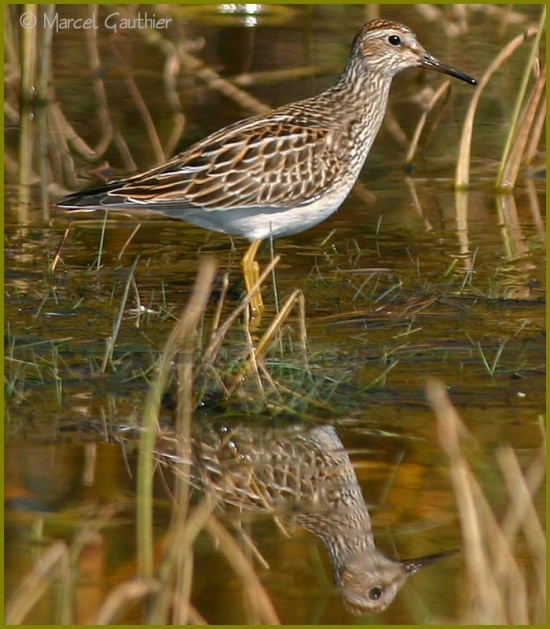- Calidris melanotos
Photo taken: Quebec
Identification
Length: 7.5 inches Medium-sized shorebird Medium-sized, thin, dark bill Yellow legs Black patch on rump extending onto tail Thin, white wing stripe Sexes similar
Adult alternate: Brown head with dark streaks Pale supercilium Black back feathers and wing coverts with brown edges Brown breast with fine streaks ending abruptly and contrasting with white underparts
Adult basic: Similar to adult alternate Upperparts a duller brown
Juvenile: Similar to adult alternate Back feathers and wing coverts with pale brown, rust, or golden edges White 'V's on back Dark rusty crown
Similar species: With its abrupt demarcation between the brown breast and the white underparts and yellow legs, the Pectoral Sandpiper is quite distinctive. It is larger than the peeps but shorter-billed and shorter-legged than dowitchers, yellowlegs, and Stilt Sandpipers. The rare Sharp-tailed Sandpiper is quite similar, but has more markings on the flanks. Juveniles have a redder crown and a more obvious supercilium.
Distribution
Breeds in north-east Siberia and northern North America from Alaska to Hudson Bay, winters in southern South America. In autumn most migrate via the Great Plains during July-September but large numbers gather at staging areas in south-east Canada and the north-eastern USA before flying south over the west Atlantic to South America. These birds are liable to meet with eastbound depressions bringing them across the Atlantic to Europe. Spring migration is mainly in April-early May and via the interior.
This is by far the most numerous Nearctic wader to occur in Europe and has been recorded in many countries from Iceland and the Faroes south to the Azores and east to Hungary, Bulgaria and Romania, also in Morocco and Israel. Annual in the British Isles, the Azores, France and Sweden.
Over 100 records in the British Isles in some years, seen throughout Britain and Ireland with most in the south-west but significant numbers in the east suggesting a Siberian rather than North American origin for many birds. Recorded throughout the year but very rare in midwinter and dramatically peaking in September-October.
Taxonomy
Habitat
Prefers freshwater habitats, often in coastal areas with damp grassland, marshland and the margins of ponds and lakes. It is found most commonly on mudflats with short grass or weedy vegetation and seems more at home in the grass than in the water.
Behaviour
Call a harsh "churk." Courtship call a hollow hooting, interspersed with growling and squawking notes. The breeding male Pectoral Sandpiper has an inflatable throat sac, which expands and contracts rhythmically during display flights. The accompanying vocalization consists of a series of hollow hoots, and is one of the most unusual sounds heard in summer on the arctic tundra.
These birds forage on grasslands and mudflats, picking up food by sight, sometimes by probing. They mainly eat insects and other invertebrates.
These birds forage on grasslands and mudflats, picking up food by sight, sometimes by probing. They mainly eat insects and other invertebrates.




